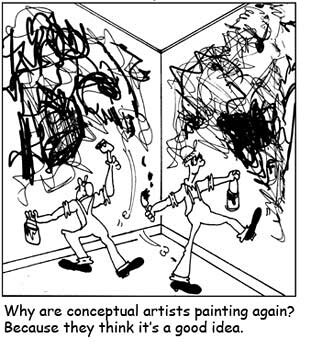Jan Verwoert
In reference to Irreverence:
Friday, November 14th, 7:30 PM
Free Admission
The building is pleased to present the second talk in a monthly series of conversations organized by the Berlin-based art critic Jan Verwoert. Please join us this Friday at 7:30 PM. Admission is free.
In reference to Irreverence
Continuing the attempt to fight the oppressive paranoia over legitimation in current thinking on art practice, the talk will address the question how the act of making references to art history in a work could be conceptualized—contrary to common opinion—as being more than just a strategic move destined to situate, position and hence legitimize the work.
As an alternative to the paradigm of stragetical moves, I will propose the paradigm of the pandemonium: Founded in opposition to the pan-theon, the house of gods (i.e. the historical canon), the pan-demonium is the house of all demons in the city of Satan. If inspiration is the moment when the spirits of other artists or thinkers make their presence felt in a work, then a way to receive that calling would be to acknowledge that one acts under the influence of other forces, to show appreciation to the muses that amuse you. Why not turn your work into a pandemonium to try and live with those ghosts?
To do so, calling those demons by their names might not be the right thing to do. Relating to them may rather be a question of how to keep and share a secret. Contrary to the strategical paradigm that portrays references as transpartent entries into the book of history, thinking through the implications of the pandemonium model may show that this must not necessarily be so. Many references to art history in current conceptual practice are in fact not presented in a manner or fashion that would render them readily understandable. It is rather a hermeticism of coded innuendo through which references are very often made today, not least as a means to bond with viewers—or alienate them.
Rather than get hung up on evaluating strategies or losses, would it not be much more revealing to discuss what ghosts we want to invoke, and even more importantly, how—in what manner, key, style or fashion—we want to do so in our work? How do we go about the practice of keeping and sharing our most treasured secrets: our sources of inspiration, influence and amusement?
***
Why are conceptual artists painting again?
Because they think it’s a good idea.
A series of talks and conversations organized by Jan Verwoert
What is the future of medium-specific practices after Conceptualism?
What is the future of Conceptual Art after the 1990s?
How have the basic conditions of art practice changed and what words and models could we use to open up the potentials at the heart of these developments in art after Conceptualism?
The dominant models no longer satisfy. It makes no sense to melodramatically invoke the “end of painting” (or any other medium-specific practice for that part) when the continuous emergence of fascinating work obviously proves apocalyptic endgame scenarios wrong. Yet, to pretend it were possible to go back to business as usual seems equally impossible because the radical expansion of artistic possibilities through the landslide changes of the 1960s leave medium-specific practices in the odd position of being one among many modes of artistic articulation, with no preset justification. How can we describe then what medium-specific practices like painting or sculpture can do today?
Likewise, it seems, that we can still not quite convincingly describe to ourselves what Conceptual Art can be: An art of pure ideas? As if “pure” idea art were ever possible let alone desirable! An art of smart strategic moves and puns? We have advertising agencies for that. The social and political dimension of Conceptualism has been discussed, but often only in apodictic terms, not acknowledging the humour, the wit, the existential, emotional or erotic aspects, as well as the iconophile, not just iconoclast motives, that have always also been at play in the dialectics and politics of life-long conceptual practices.
The talk will start off a series of monthly talks and conversations about the conditions of contemporary practice. The idea is to invent a new language together in discussions that could describe the potentials of contemporary practice; a language that would acknowledge a shared sense of crisis and doubt, yet fight the senseless paranoia over legitimation that too much bad-faith criticism today exploits in the wake of second-generation institutional critique. In other words: how could, in response to the concerns of contemporary art practice, a critical vocabulary be developed that would break the spell of the oedipal infatuation with the laws of (institutional) legitimacy – and instead help to transform criticism into a truly gay science based on a shared sense of appreciation and irreverence?
Jan Verwoert is an art critic based in Berlin. He is a contributing editor to Frieze magazine and also writes regularly about contemporary art for such art magazines as Afterall, Metropolis M. Teaches at the MA Fine Arts department at the Piet Zwart Institute Rotterdam.
The building is an e-flux project in cooperation with Fruit & Flower Deli. The building is open Thursday through Saturday, 12 – 6 pm. Come visit!
For further information please contact Magdalena Magiera: [email protected]
the building
Platz der Vereinten Nationen 14a
10249 Berlin DE
T: 030 28 04 79 73
For more information go to: http://www.e-flux.com


